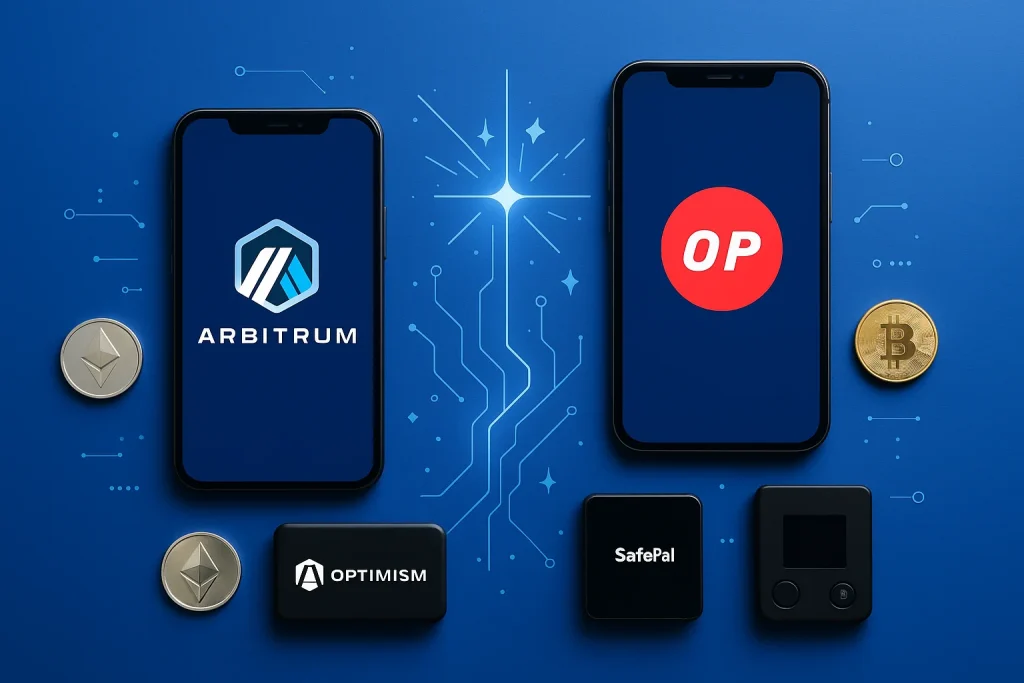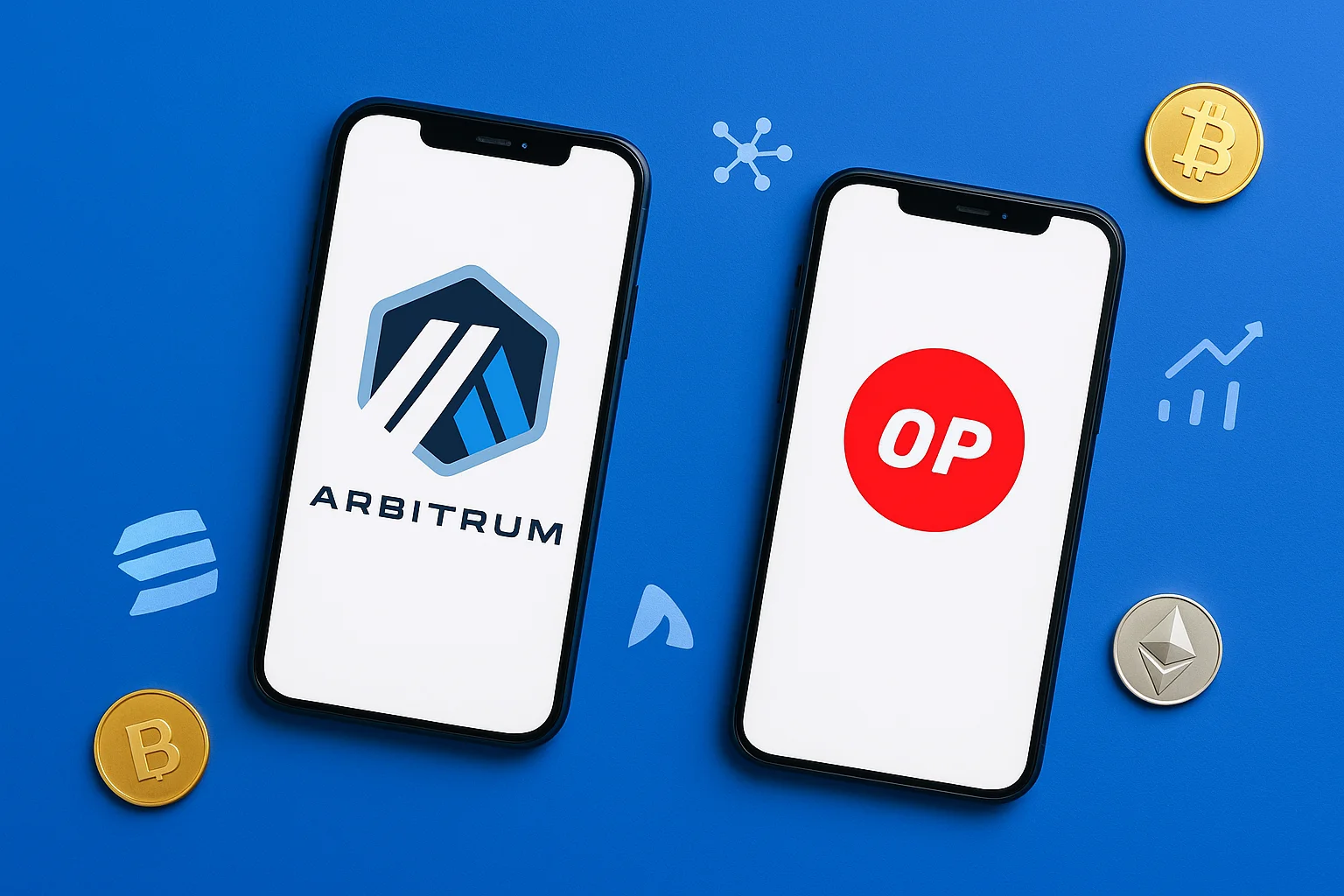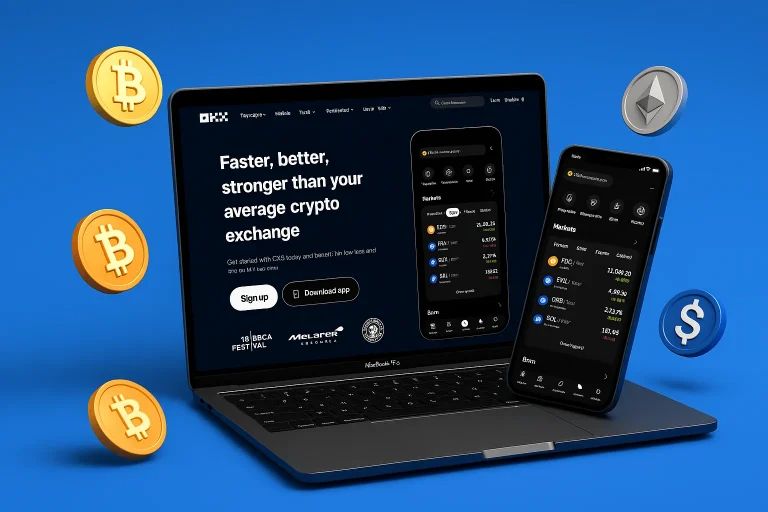As blockchain technology advances, the demand for seamless communication between Layer-2 solutions and the mainnet has never been higher. Without efficient scaling, users and developers face frustrating delays and rising costs that hold back adoption.
Improving network performance is crucial for Layer-2 platforms like Arbitrum and Optimism. Both aim to solve these challenges but employ different approaches, resulting in varying speeds, costs, and usability outcomes. With a strong presence in the ecosystem, these two solutions are driving innovation and gaining momentum, as reflected in their daily active users and developer activity.
Let’s compare Arbitrum vs. Optimism and see what makes each a contender in the race to scale Ethereum efficiently.
Table of contents
Optimism vs. Arbitrum: A Brief Overview |
|
|---|---|
| Arbitrum | Best for: High TPS with EVM compatibility Key Feature: Optimistic Rollups + Customizable Gas Fees Type: Layer-2 Scaling Solution Transaction Speed: ~27 TPS (peak ~1,100 TPS) Block Time: ~0.25 seconds Transaction Cost: Very Low Virtual Machine: Arbitrum VM (EVM compatible) Programming Languages: Solidity, Vyper, Flint, LLL, YUL+, Stylus Smart Contracts: Supported Consensus: Ethereum PoS Gas Fees: Customizable Token: ARB (Governance) Adoption: Rapid growth, strong dApp support |
| Optimism | Best for: Fast integration with the Ethereum ecosystem Key Feature: OVM + Strong DeFi & ETH dev support Type: Layer-2 Scaling Solution Transaction Speed: ~15 TPS (peak ~180 TPS) Block Time: ~2 seconds Transaction Cost: Low Virtual Machine: Optimism VM (EVM compatible) Programming Languages: Primarily Solidity Smart Contracts: Supported Consensus: Ethereum PoS Gas Fees: Fixed Token: OP (Governance) Adoption: Growing daily active users, solid ETH integration |
The Genesis of Arbitrum vs. Optimism

Arbitrum and Optimism stepped up in 2021 when Ethereum gas fees made even simple transactions feel like luxury purchases. At that point, Layer-2s weren’t just nice-to-haves but necessary. These two protocols began swinging with roll-up technology that promised to scale Ethereum without compromising security or decentralization.
Optimism went live first, providing critical infrastructure through Optimistic Rollups to compress transactions, push them off-chain, and settle them back on Ethereum in batches. The idea is straightforward: transactions are assumed to be valid unless someone proves otherwise. That means fewer on-chain computations and much cheaper gas.
From day one, Optimism branded itself as Ethereum-aligned. It kept things lean, focused on EVM equivalence, and pushed for long-term public goods funding with its retroactive rewards model. Builders liked it for the low friction. Ethereum maxis liked it because it didn’t try to reinvent anything but scaled what already worked.
Arbitrum, launched not long after by Offchain Labs, took a similar route with Optimistic Rollups but packed some extra features under the hood. It gave developers more flexibility, introduced a more advanced dispute resolution system, and managed to undercut Optimism on fees early on. That combo helped it rack up integrations fast, especially across the growing Arbitrum ecosystem, with strong traction in the DeFi space.
Where Optimism focused on governance experiments and ecosystem alignment, Arbitrum leaned into performance. The Nitro upgrade leveled up throughput and reduced latency. Then came Arbitrum Orbit, which let teams spin up their rollups on top of Arbitrum. That moved it beyond optimistic rollups and an entire rollup-as-a-service stack.
Arbitrum Nova also entered the picture here (a sidechain with up to 90% lower gas fees than the regular Arbitrum chain). Although it sacrifices some security, Arbitrum Nova is ideal for gaming, social, and other high-bandwidth applications. OpenSea and TreasureDAO launched marketplaces on Nova, laying the key infrastructure for future projects.
Both protocols solve the same bottleneck (Ethereum’s limited block space) but cater to different vibes. Unlike Arbitrum, Optimism Bedrock tightly integrates with the Ethereum ecosystem, aligning its roadmap with long-term protocol upgrades and developers’ needs. Arbitrum is gunning for dev adoption, fast execution, and modular infrastructure.
So, if you’re building or bridging, the choice often comes down to what you prioritize: simplicity and Ethereum-native philosophy or performance and customizability.
Arbitrum vs. Optimism: Technical Comparison

Winner: Arbitrum (ARB)
Arbitrum offers greater decentralization, advanced tooling, and higher throughput, while Optimism focuses on simplicity, native EVM compatibility, and a smoother developer experience.
Blockchain, Architecture, and Consensus Mechanisms
Arbitrum and Optimism are both Layer-2 solutions built on Ethereum. They use Optimistic Rollups to scale the network by handling transactions off-chain and settling data on-chain. While their end goals are the same, their technical architectures reflect different priorities.
Arbitrum runs on a custom execution environment (ArbOS) and uses its virtual machine (AVM), which is compatible with the Ethereum Virtual Machine (EVM) but allows developers to write smart contracts in other languages like Rust and C through Stylus.
It uses an interactive, multi-round, fraud-proof system. This system lets validators isolate specific steps in a disputed transaction instead of re-running the whole thing, keeping on-chain costs low when verifying fraud and executing transactions efficiently.
Validator participation is permissionless, meaning anyone can submit or challenge fraud proofs during the dispute window, typically lasting 7 to 14 days.
Optimism uses a simpler design, sticking with a pure EVM-equivalent stack called the Optimism Virtual Machine (OVM). This makes it easier for Ethereum-native developers to migrate code without changes.
Its fraud-proof system is non-interactive and single-round, meaning if someone raises a challenge, the entire transaction has to be re-executed on Ethereum. While this approach is easier to implement, it can be more expensive during disputes. Optimism relies on a centralized sequencer operated by OP Labs, and fraud proofs are not yet live in production.
However, its Bedrock upgrade laid the foundation for more modular architecture and future decentralization, including an upcoming Cannon system, which will bring interactive proofs and improved security assumptions.
Both rollups inherit Ethereum’s Proof of Stake consensus, but Arbitrum adds an extra coordination layer with its validator logic. Optimism keeps consensus as simple as possible, outsourcing trust entirely to Ethereum while focusing on developer experience and compatibility.
In practice, Arbitrum’s setup is more complex but more decentralized. Optimism is simpler and more tightly aligned with Ethereum, though not fully trustless (yet).
Scalability and Network Throughput
As of June 26, 2025, Arbitrum handles around 23.6 transactions per second (TPS) in real-time, with a maximum TPS of 85.4 across recent 100-block windows. Theoretical throughput reaches up to 4,000 TPS, depending on call data compression and sequencer congestion. Block time sits at 0.26 seconds, offering fast confirmations and low latency. Like most Ethereum Layer-2s, finality clocks in at 16 minutes, synced to Ethereum’s finality.
Optimism, in contrast, runs at roughly 14.9 TPS in real time, with a max TPS of 181. Its theoretical ceiling hits 714.3 TPS, and block time is higher at 2 seconds. Finality also takes 16 minutes since it inherits Ethereum’s finalization rules.
Looking at transaction volume, Arbitrum can process transactions at a much higher rate, logging over 96,000 daily transactions, compared to 53,761 on Optimism. That’s nearly double, a meaningful gap for high-traffic applications.
The faster block time and broader throughput range give Arbitrum the edge for projects that need scalability baked in (think DEXs, games, or social protocols). Optimism still holds firm on EVM compatibility and shared sequencing plans with the Superchain, but Arbitrum is ahead in raw scalability.
The data included in this section are from Chainspect.
Programming Languages and Smart Contract Compatibility
Arbitrum is fully EVM-compatible, meaning developers can deploy Solidity-based smart contracts without rewriting code. It uses the Optimistic Virtual Machine (OVM) for execution, but with an architecture designed to stay as close to Ethereum’s tooling and developer workflows as possible. Whether you’re deploying via Hardhat, Remix, or Foundry, it’s plug-and-play.
Optimism takes a similar approach. Since the Bedrock upgrade, it’s almost a mirror image of Ethereum in terms of bytecode and tooling support. Developers can write in Solidity, use existing Ethereum infrastructure, and expect consistent behavior across both chains.
Arbitrum supports more advanced tooling under the hood, such as Arbitrum Stylus, which expands contract support beyond Solidity to include Rust, C, and C++. That’s a major bonus for teams that are used to those languages. Optimism, for now, sticks strictly to EVM-compatible Solidity, intentionally keeping things lean and Ethereum-aligned.
Both chains offer strong Solidity support, but Arbitrum gives developers more options if they want to go off the beaten path of EVM. Optimism plays it closer to Ethereum’s core, making it ideal for teams that just want native compatibility without extra complexity.
Arbitrum vs. Optimism: Market Performance

Winner: Arbitrum (ARB)
Arbitrum outperforms Optimism in market cap, TVL, and user engagement, while Optimism sees higher volatility and bearish sentiment despite bursts of speculative trading.
Market Capitalization and TVL
As of late June 2025, Arbitrum’s market capitalization was around $1.5 billion, significantly ahead of Optimism’s $935 million. Depending on the source, Arbitrum fluctuates slightly between $1.48B and $1.52B, while Optimism hovers in the $920M to $950M range.
Regarding Total Value Locked (TVL), Arbitrum leads by an even wider margin. It currently secures about $2.4 billion in DeFi TVL, placing it first among all Ethereum Layer-2s. Optimism trails at around $366 million, capturing approximately 15% of Arbitrum’s locked value.
Despite fluctuations in USD valuation, Arbitrum consistently maintains higher user and developer engagement across key DeFi protocols.
Supply and Price Action
As for token supply, Arbitrum has a total and max supply of 10 billion ARB, with nearly 5 billion in circulation (~50%). OP’s total and max supply sit at 4.29 billion, with 1.75 billion circulating (~41%).
ARB is currently trading around $0.30, with mild daily swings. Conversely, OP trades near $0.53–$0.55, though it’s down roughly 70% from one year ago, reflecting more bearish sentiment over time.
Trading Volume and Market Sentiment
Arbitrum shows consistent on-chain activity, with 24-hour trading volumes typically ranging from around $180 million to $215 million. This represents roughly 14% of its market capitalization, indicating solid liquidity and steady user engagement.
Market sentiment for Arbitrum leans neutral to slightly bearish. Technical indicators show sideways price movement and occasional minor pullbacks, but no major sell-offs. The overall outlook suggests a patient market holding through recent volatility.
Optimism’s 24-hour trading volume is generally lower, fluctuating between $145 million and $160 million. However, its volume-to-market-cap ratio is higher (often between 17% and 33%), reflecting greater volatility and more speculative trading.
Sentiment around Optimism is more bearish, with a significant price decline over the past year. Despite short-term rebounds pushing the Fear & Greed index toward “Greed,” bearish signals dominate, and market watchers expect continued downside pressure in the near term.
Top Practical Uses of Arbitrum vs. Optimism
Winner: Arbitrum (ARB)
Arbitrum outperforms Optimism in market cap, TVL, and user engagement, while Optimism sees higher volatility and bearish sentiment despite bursts of speculative trading.
Arbitrum excels in scenarios demanding high performance, low costs, and extensive developer flexibility:
- High-Traffic DeFi & Gaming – Arbitrum’s superior throughput and cheaper fees are ideal for decentralized finance (DeFi) applications with high transaction volumes and blockchain-based games.
- Multi-Language Development – With Stylus, developers can build smart contracts using Rust, C, and C++ alongside Solidity, enabling more diverse and performant applications.
- Custom Blockchain Solutions – Arbitrum Orbit allows projects to launch their Layer-3 chains, providing tailored environments for specific use cases.
Optimism is preferred for its Ethereum alignment, development simplicity, and interconnected ecosystem:
- Seamless dApp Migration – Its strict EVM equivalence makes it incredibly easy for existing Ethereum dApps to migrate with minimal code changes.
- Unified “Superchain” Vision – Optimism’s OP Stack fosters an interoperable network of rollups, promoting seamless interaction and shared infrastructure among chains like Base.
- Public Goods Focused Projects – Optimism’s commitment to retroactive public goods funding attracts projects aligned with a sustainable, community-driven Ethereum ecosystem.
Arbitrum vs. Optimism: Where Are They Heading?
Arbitrum and Optimism are leading Ethereum Layer-2 solutions, each carving out distinct paths to grow their market share and developer communities.
Optimism’s future hinges on the OP Stack, a modular framework designed not just for optimistic rollups but as a blueprint for interoperable, scalable blockchains. The OP Stack’s first major release, Bedrock, introduced modularity by separating consensus, execution, and data availability layers, resulting in lower fees and faster syncing.
Optimism also works closely with Coinbase on Base, a Layer-2 blockchain built on the OP Stack. Their goal is a unified “Superchain” where rollups share sequencers, proofs, and bridges to communicate seamlessly, making scaling Ethereum less fragmented and more efficient.
By providing critical infrastructure for Layer-2 chains and prioritizing standardization, Optimism positions itself as a key scaling tool for decentralized finance within the Ethereum ecosystem.
Arbitrum launched Arbitrum Nova, a sidechain boasting up to 90% lower gas fees than the main chain, optimized for gaming and social apps where high bandwidth is crucial. Arbitrum’s Stylus upgrade introduced the Arbitrum Virtual Machine (AVM), enabling smart contracts written in Rust, C, and C++ to work alongside Solidity contracts, expanding developer options and improving performance.
Arbitrum Orbit allows developers to launch permissionless Layer-3 chains within its ecosystem, further broadening its scalability and flexibility.
So, Optimism doubles down on modularity and interoperability with the OP Stack and the Superchain vision, focusing on standardization and ecosystem cooperation. Arbitrum prioritizes expanding developer reach and lowering transaction costs through its Stylus upgrade, Nova sidechain, and Layer-3 initiatives. Both aim to scale Ethereum, but their strategies highlight different strengths: Optimism with a unified network of rollups and Arbitrum with a versatile, developer-friendly multi-layer ecosystem.
FAQ
Arbitrum leads the Layer-2 space in total value locked, daily active users, and developer adoption. It processes Ethereum transactions using optimistic rollups, offering lower fees and faster execution. Arbitrum supports advanced tools like Arbitrum Orbit, Arbitrum Nova, and the Arbitrum Virtual Machine, making it easier to build future projects and scale the Arbitrum ecosystem. With a strong market share, solid network performance, and deep compatibility with existing Solidity-based contracts, Arbitrum is currently the top Layer-2.
Regarding usage and infrastructure, Arbitrum vs. Optimism leans in Arbitrum’s favor. Arbitrum handles more daily active users, has greater liquidity, and supports a more secure fraud-proof mechanism through multi-round fraud proofs. It also enables executing transactions at lower cost. Optimism uses single-round fraud proofs, and while the OP Stack gives it strong ties to the Ethereum network, Arbitrum offers better transaction throughput, lower transaction costs, and a more established ecosystem growth track.
Both Arbitrum and Optimism inherit the security of the Ethereum mainnet, but their fraud-proof mechanisms differ. Arbitrum employs multi-round fraud proofs, which offer more precise verification and reduce the chances of invalid transaction data going unnoticed. Optimism is moving away from single-round fraud proofs but hasn’t fully implemented multi-round verification yet. So, in terms of validating transactions, Arbitrum currently has stronger network security.
Yes, both platforms carry risk. Smart contract bugs, bridge failures, or sudden market volatility can lead to loss of funds. High gas fees, especially during network congestion, can also impact costs. Since Arbitrum and Optimism process off-chain transactions using optimistic rollups, users are still exposed to off-chain risks and must vet smart contracts before interacting.
No, they’re not. Both Optimism and Arbitrum are optimistic rollups that bundle multiple transactions and post data to Ethereum.
Arbitrum is an optimistic rollup, not a ZK rollup. It assumes transaction validity unless proven otherwise during a challenge period. This approach improves cost efficiency and allows Arbitrum to process large Ethereum transactions with lower gas fees than L1.
Using third-party bridges like Hop, Across, or Orbiter, you can move assets between the Arbitrum network and Optimism. These tools enable a seamless transition between Layer-2s by transferring assets off-chain. Expect transaction fees and delays depending on Ethereum network activity and bridge mechanics.
Final Thoughts
So, if you want straightforward speed, lower fees, and a bigger ecosystem, Arbitrum is the safer bet right now. Its focus on flexibility, multi-language support, and scalable layers gives developers more room to experiment and grow projects.
Plus, innovations like Arbitrum Orbit and Nova are building an infrastructure that’s not just about Ethereum scaling but also about supporting new apps.
If you prefer tight Ethereum alignment, simplicity, and a roadmap deeply connected to the core Ethereum upgrades, Optimism could be your pick. It’s more minimalist and focused on long-term modularity, which might suit teams wanting pure Ethereum compatibility with less complexity.
However, for raw performance, broader dev tools, and a more mature market presence, Arbitrum edges out as the more versatile and promising Layer-2 solution. If scaling Ethereum with speed and options matters most, you’ll want to watch Arbitrum.




